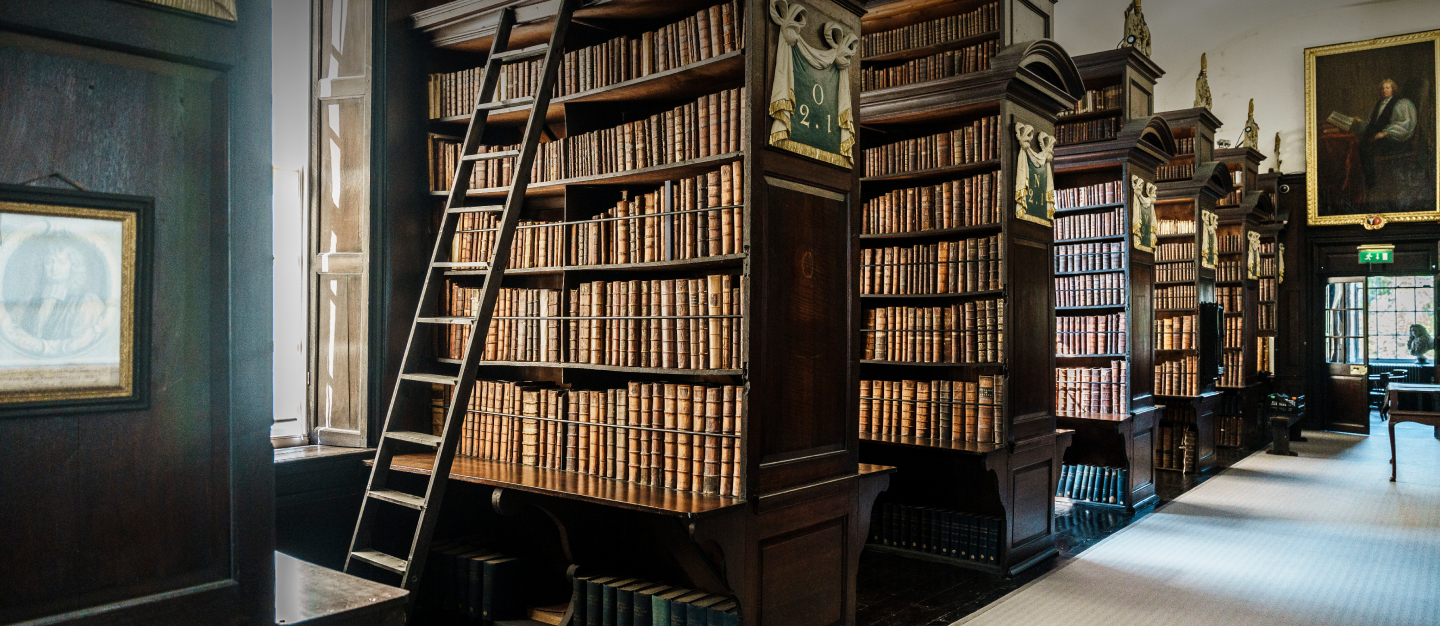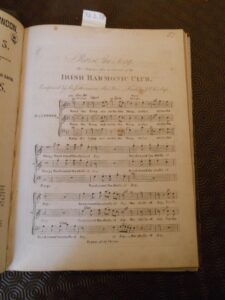
Dr Tríona O’Hanlon and research on the Hibernian Catch Club
“Let’s Have a Catch and not a Glee”
Our research fellow Dr Triona O’Hanlon gave a talk on her research on the collection of the Hibernian Catch Club at 6.30 pm on Tuesday 7 April in the Dublin City Library & Archive, 138-144 Pearse Street. The lecture was presented by the Irish Society for Archives in conjunction with their AGM and was received with great interest by the audience.
at 6.30 pm on Tuesday 7 April in the Dublin City Library & Archive, 138-144 Pearse Street. The lecture was presented by the Irish Society for Archives in conjunction with their AGM and was received with great interest by the audience.
Here she writes about the research she carried out at Marsh’s:
Marsh’s Library holds a large archive of sources pertaining to the Hibernian Catch Club, one of Dublin’s oldest music societies. The society was established in c.1680 by the vicars choral of St Patrick’s and Christ Church Cathedrals.
During my fellowship I examined 30 volumes of music, from which I catalogued 68 items for Répertoire International des Sources Musicales Ireland (RISM Ireland, www.rism- ie.org). I examined minute books, programmes, miscellaneous papers, dinner and membership lists in order to carry out a comparative study of the society for the period 1797-1805 and 1897-1905.
 Catches and Glees are song types; a catch is best described as a comic round for 3 or 4 voices and a glee is a type of part-song typically written for up to 5 voices. Both song types were written for male voices, however some glees were written to include female voices. The photograph to the left illustrates the music for
Catches and Glees are song types; a catch is best described as a comic round for 3 or 4 voices and a glee is a type of part-song typically written for up to 5 voices. Both song types were written for male voices, however some glees were written to include female voices. The photograph to the left illustrates the music for a catch for 4 voices, Call the waiter, by the English composer John Danby (c.1757-1798). The photograph to the right illustrates music for the Glee Raise the Song composed by John Stevenson (c.1761 or 1767-1833). Stevenson was a leading Irish composer and he was also a member of The Hibernian Catch Club. This glee, which was written for 3 solo voices and chorus, was performed at all of the Club’s monthly dinner meetings which took place between 12 January 1897 and 8 November 1904.
a catch for 4 voices, Call the waiter, by the English composer John Danby (c.1757-1798). The photograph to the right illustrates music for the Glee Raise the Song composed by John Stevenson (c.1761 or 1767-1833). Stevenson was a leading Irish composer and he was also a member of The Hibernian Catch Club. This glee, which was written for 3 solo voices and chorus, was performed at all of the Club’s monthly dinner meetings which took place between 12 January 1897 and 8 November 1904.
Hundreds of items of sheet music are extant in the collection; some works are in manuscript form, however most of the music is printed. Membership of the The Hibernian Catch Club was exclusively male, musical ability was taken into account and both amateur and professional singers were permitted to join. The Club dined out once a month from September to June and weekly meetings took place between the monthly dinners. Members had to pay 1 British shilling to attend weekly meetings, 5 shillings to attend on dinner days and if absent fines were imposed. Members were permitted to invite guests to dinner meetings. Ladies were invited to attend dinner meetings on occasion. Expenses associated with running the Club included the purchase, binding and copying of music, piano hire, dinner bills, sending letters of invitation to dinner guests, printing and advertising.
 The first page from the Club’s minute book for the period 1797-1812 is illustrated in the photograph to the left. The photograph on the right illustrates a menu from the dinner meeting which took
The first page from the Club’s minute book for the period 1797-1812 is illustrated in the photograph to the left. The photograph on the right illustrates a menu from the dinner meeting which took  place on 13 February 1900 at the Ancient Concert Rooms, Dublin. Dishes included Bisque á la creme, salmon tartare and parsley sauce, chicken and ham, and strawberry sponge rusks.
place on 13 February 1900 at the Ancient Concert Rooms, Dublin. Dishes included Bisque á la creme, salmon tartare and parsley sauce, chicken and ham, and strawberry sponge rusks.
The Hibernian Catch Club contributed to the development of Dublin’s music network and to the dissemination of repertory. Almost 180 years of the Club’s history is recorded in the archives extant in Marsh’s Library.



